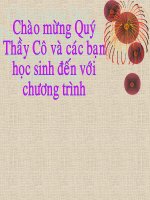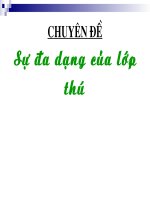Tải Giáo án tiếng Anh lớp 9 Tuần 3 sách mới - Giáo án điện tử môn tiếng Anh 9 theo tuần
Bạn đang xem bản rút gọn của tài liệu. Xem và tải ngay bản đầy đủ của tài liệu tại đây (108.99 KB, 7 trang )
<span class='text_page_counter'>(1)</span><div class='page_container' data-page=1>
<b>GIÁO ÁN TIẾNG ANH LỚP 9 </b>
<b> TUẦN 3</b>
<b>NĂM HỌC 2019 - 2020</b>
<i><b>Period: 7 </b><b> </b><b> Week: 3</b></i>
<b>Unit 1: LOCAL ENVIRONMENT</b>
<i><b>Lesson 6 – SKILLS 2</b></i>
<b>I. OBJECTIVES: By the end of this Unit, students will be able to:</b>
Listen for specific information about places of interest in an area
Write an email to give information about places of interest in an area and
things to do there
<b>II . PREPARATION: sub -board, pictures, cassette </b>
<b>III. PROCEDURES: </b>
<b>Teacher’s and students’ activities</b> <b>Content</b>
<b>Activity 1: </b>
-Tell Ss that they are going to listen to three
students talking about their places of interest.
Before listening, Ss look at the pictures and describe
what they see in each of them. Elicit answers from
different Ss. Ask them if they know the name of
each place. Quickly write these names on the board.
Play the recording for Ss to check their answers.
<b>Activity 2:</b>
-Play the recording again for Ss to decide if the
sentences are true or false. If they meet any
difficulty doing this, play the recording one more
time. Have Ss compare their answers in pairs before
giving T the answers. Ask for Ss' answers and write
them on the board. Do not confirm the correct
answers yet.
<b>Activity 3:</b>
-Without listening to the recording again, Ss
A. Ha Noi Botanical Garden
B. Bat Trang Pottery village
C. Viet Nam National Museum of
History
1. T
2. T
3. F
(His friend’s relatives own it.)
4. F
(They also come from other
countries.)
5. T
</div>
<span class='text_page_counter'>(2)</span><div class='page_container' data-page=2>
complete the table by filling each blank with no
more than three words. Ss compare their answers
with a classmate before giving T the answers. Ask
two Ss to write their answers on the board. Play the
recording one last time to confirm the answers for
<b>both 2 and 3.</b>
<b>WRITING</b>
<b>-Activity 4:</b>
Ss work in pairs and discuss the places of interest in
their hometown/city that can be visited in one day
and the activities that can be done there. Remind Ss
that these places of interest should be most typical
and worth visiting. T should move around to, give
comments as there may not be enough time for
checking with the whole class.
<b>Activity 5:</b>
-Ss write the email, using the notes they have made.
Ss may also write this in groups on big pieces of
paper. Ss or groups exchange their descriptions to
spot any mistakes. Share them with the whole class.
T may collect some Ss' work to mark at home or ask
them to rewrite the email as homework. In this case,
remember to ask for Ss' revised work in the next
lesson
2. exploring Vietnamese culture
3. make things
4. paint on ceramics
5. the hill
6. books
7. pigeons
8. watching
Dear Mira,
It's great to know that you're coming
to Viet Nam. What a pity you can
only spend one day in Ha Noi.
There are so many interesting
places in the city, but I think
within one day you should be
able to visit three places. The
first place I suggest is Viet Nam
National Museum of History. You
like history, so it's
a must-see place. There's an
extensive collection of artifacts
tracing Viet Nam's history. They're
arranged chronologically from
primitive life to modern times.
The second place is Hoan Kiem
Lake. It's one
</div>
<span class='text_page_counter'>(3)</span><div class='page_container' data-page=3>
houses to explore
Vietnamese culture.
Conveniently, these places are close
to one another, so we can walk
around easily.
Tell me when you're coming, so I
can show you around these places.
Look forward to seeing you soon!
Best wishes,
Thuc Anh
<b>IV- HOMEWORK:</b>
-Write new words then learn them by heart.
-Copy the exercise into notebooks.
-Prepare LOOKING BACK
Period: 8 Week: 3
<b>Unit 1: LOCAL ENVIRONMENT</b>
<i><b>Lesson 7 – LOOKING BACK</b></i>
<b>I. OBJECTIVES: By the end of this Unit, students will be able to:</b>
Use some vocabularies and structures to talk about traditional crafts and
<b>places of interest in an area </b>
<b>II . PREPARATION: sub -board, pictures, cassette </b>
<b>III. PROCEDURES: </b>
<b>Teacher’s and students’ activities</b> <b>Content</b>
<b>Activity 1: </b>
-Ss complete the word web individually. Check Ss'
answers as a class. If time allows, ask one or two Ss
to write their answers on the board.
<b>Activity 2:</b>
-Ss do this exercise individually, then compare their
answers with a partner. Elicit the answers from Ss.
<i><b>( in any other )</b></i>
1. paintings 2. pottery
3. drums 4. marble
sculptures
5. silk 6 lacquerware
7. lanterns 8. conical hats
</div>
<span class='text_page_counter'>(4)</span><div class='page_container' data-page=4>
<b>Activity 3:</b>
-Ss do this exercise individually. Have some Ss read
out their answers. Confirm the correct ones.
<b>Activity 4:</b>
-Ss complete the sentences with their own ideas.
Call on two Ss to write their answers on the board.
Other Ss give feedback. Check their answers.
<b>Activity 5:</b>
-Ss write the sentences individually. Have two Ss
write the sentences on the board. Ask other Ss to
give comments. Correct the sentences if needed.
<b>Activity 6:</b>
-Ss work in groups to play the game. One student is
the group secretary. Group members take turns to
think of a place of interest in their area. Other Ss
ask Yes/No questions to guess the place. The
secretary writes down all the places of interest they
have guessed. Finally, the secretary reports on the
places.
-Finished! Ask Ss to complete the self-assessment.
Identify any difficulties and weak areas and provide
further practice.
<i><b>Project: What makes you proud of your area?</b></i>
-Have Ss read the project. Ask them what the one
special thing about their area is. Elicit Ss' answers.
Ss work in groups to do the project. Ss follow the
instructions in the book. Answer Ss' questions if
3. wove 4. knitted
5. carved 6. moulded
1. zoo 2. looking forward
to
3. looked 4. team-building
5. lunch 6. museum
7. craft 8. interest
1. I don't remember exactly when
my parents set up this workshop.
2. We have to try harder so that our
handicrafts can keep up with theirs.
3. What time will you set off for Da
Lat?
4. We arranged to meet in front of
the lantern shop at 8 o'clock, but she
never turned up.
</div>
<span class='text_page_counter'>(5)</span><div class='page_container' data-page=5>
there are any. Remember to have Ss present their
findings in the next lesson and vote for the best.
<b>IV- HOMEWORK:</b>
-Write new words then learn them by heart.
-Copy the exercise into notebooks.
<b>-Prepare GETTING STARTED - Unit 2</b>
Period: 9 Week: 3
<b>Unit 2: CITY LIFE</b>
<i><b>Lesson 1 - GETTING STARTED</b></i>
<b>I. OBJECTIVES: By the end of this Unit, students will be able to:</b>
Use some vocabularies and structures to talk about city life
<b>II . PREPARATION: sub -board, pictures, cassette </b>
<b>III. PROCEDURES: </b>
<b>Teacher’s and students’ activities</b> <b>Content</b>
Introduction
Review the previous unit by asking Ss to solve a crossword
puzzle. Draw the crossword on the board. Tell Ss that the
words in the orange column are the key words of the new
unit. Divide the class into two teams. Ss from each team
take turns to solve the puzzle. The game finishes when a
student guesses the orange words correctly.
T may also ask Ss to name all the places of interest or main
features of their neighbourhood.
Activity 1:
Ask Ss to open their books to Unit 2. Ask them
some questions. Questions may include:
• What can you see in the pictures?
• Do you know these two boys?
• Where are they now?
</div>
<span class='text_page_counter'>(6)</span><div class='page_container' data-page=6>
… Ss answer the questions as a class.
T may also ask Ss what they know about Sydney by
asking them some guiding questions:
• Where is it?
• Is it a capital city?
• What is it famous for?
Then play the recording and have Ss follow along.
a./ Ask Ss to read the conversation again and do the
exercise individually. Check and write the correct
answers on the board.
b./ Ss work in pairs to do the task. Allow Ss to share
answers before asking them to discuss as a class.
Remember to ask Ss to read out the lines in the
conversation that contain the words. Check and confirm the
correct answers.
c./ Ss work individually to answer the questions, then
compare their answers with a partner. Ask them to
locate the information in the conversation. Call on some
pairs to give the questions and answers. Confirm
the correct answers.
d./ Tell Ss to find the phrases in the conversation and
practise saying them together. Explain the meaning to Ss,
then elicit other examples from Ss.
Key:
1. visit 2.ancient 3.natural
4.variety 5.study
Key:
1. jet lag
2. a feature
3. reliable
4. metropolitan
5. multicultural
Key:
1. He grew up in Sydney.
2. Sydney is.
3. It is convenient and
reliable.
4. Because it is a
metropolitan and
multicultural city.
5. In 1850.
Key:
1. How are you?/How are
things?/How are you doing?
2. (Are you) recovering
from the jet lag?
</div>
<span class='text_page_counter'>(7)</span><div class='page_container' data-page=7>
Activity 2:
Tell Ss that most of the words they need to use are related
to cities or city life. Let them work in pairs.
Check their work, then let them read each word correctly.
Check and correct their pronunciation
Activity 3: Ss work in pairs. Give them a few minutes to do
the quiz. Award extra points for pairs who can say which
country these cities are in. Congratulate the winners.
trouble/It’s not a
problem/It’s my pleasure.
Key:
1. international 2. local
3.crowded
4. neighbouring 5. Urban
Key:
1.A 2.C 3.C 4.A 5.C 6. B
<b>IV- HOMEWORK:</b>
-Practice reading the dialogue.
-Write new words then learn them by heart.
-Copy the exercise into notebooks.
-Prepare A CLOSER LOOK 1
Mời bạn đọc tham khảo thêm tài liệu Tiếng Anh lớp 9 tại đây:
Bài tập Tiếng Anh lớp 9 theo từng Unit:
Bài tập Tiếng Anh lớp 9 nâng cao:
</div>
<!--links-->









